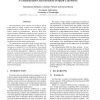Free Online Productivity Tools
i2Speak
i2Symbol
i2OCR
iTex2Img
iWeb2Print
iWeb2Shot
i2Type
iPdf2Split
iPdf2Merge
i2Bopomofo
i2Arabic
i2Style
i2Image
i2PDF
iLatex2Rtf
Sci2ools
97
Voted
IISWC
2009
IEEE
2009
IEEE
A communication characterisation of Splash-2 and Parsec
Recent benchmark suite releases such as Parsec specifically utilise the tightly coupled cores available in chipmultiprocessors to allow the use of newer, high performance, models of parallelisation. However, these techniques introduce additional irregularity and complexity to data sharing and are entirely dependent on efficient communication performance between processors. This paper thoroughly examines the crucial communication and sharing behaviour of these future applications. The infrastructure used allows both accurate and comprehensive program analysis, employing a full Linux OS running on a simulated 32-core x86 machine. Experiments use full program runs, with communication classified at both core and thread granularities. Migratory, read-only and producer-consumer sharing patterns are observed and their behaviour characterised. The temporal and spatial characteristics of communication are presented for the full collection of Splash-2 and Parsec benchmarks. Our results aim to...
Communication | Crucial Communication | Efficient Communication Performance | IISWC 2009 | Operating Systems |
Related Content
| Added | 24 May 2010 |
| Updated | 24 May 2010 |
| Type | Conference |
| Year | 2009 |
| Where | IISWC |
| Authors | Nick Barrow-Williams, Christian Fensch, Simon Moore |
Comments (0)

